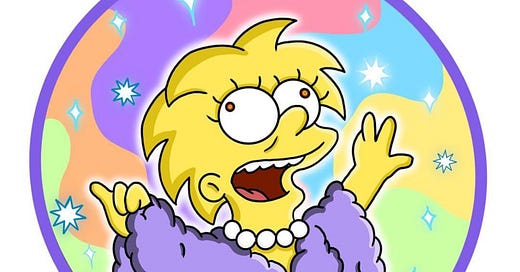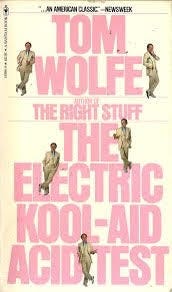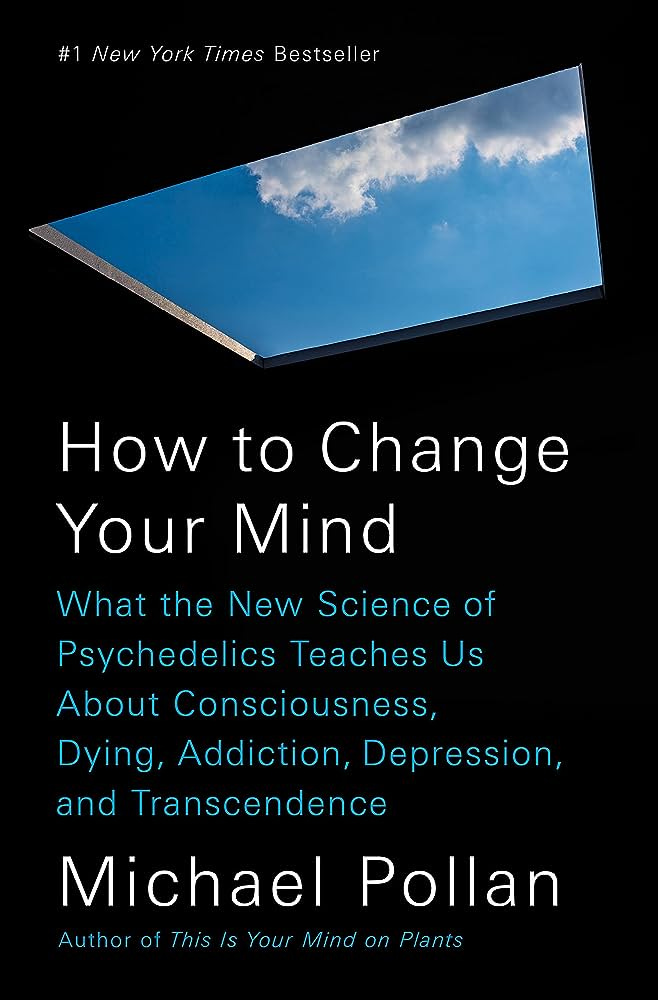One Grateful Summer and Two Trippy Books
Back in June, Seth and I drove to Raleigh to see Dead & Co on their final tour. I’ve listened to hundreds of Dead Shows over the years, but I had never seen Mickey Hart work his particular magic through Drums and Space, and there was something glorious about being there at Walnut Creek, after the storm cleared and the evening shifted to darkness, with the bass and drums throbbing through my nerve endings, clinging to Seth like a life preserver. When I came out on the other side of that, I felt transformed, awash in gratitude and love and all the semi-cringe hippie stuff you might expect, but holy shit it was amazing.
After that, I didn’t exactly tune in and drop out. Instead, I did what I always do when something fascinates me: I read a book about it, two actually. First Tom Wolfe’s Electric Kool Aid Acid Test and then How to Change Your Mind by Michael Pollan.
The Mad Ones
In Acid Test, Wolfe embeds himself in the lives of the Merry Pranksters, a cult of personality led by the ruggedly charming author of One Flew Over the Cuckoo’s Nest, Ken Kesey, as they travel the country and host the first-ever acid tests—long, wild, day-glo romps fueled by LSD, weed, and amphetamines (and scored by The Grateful Dead).
I was surprised, as I read Acid Test, by how disillusioned I became with Kesey himself. One Flew Over The Cuckoo’s Nest held the coveted title of Stephanie’s Favorite Book throughout my college years, and I always saw Kesey as a counterculture hero. But in Acid Test, Wolfe paints him as a puppeteer without a plan, or worse, a master manipulator who used his accolades and acolytes to shield himself from the consequences of his actions.
I felt especially drawn to one prankster, Sandy Lehmann-Haupt aka Dis-MOUNT, an audio engineer who takes up with Kesey at the very beginning, installing the sound system on the bus. Sandy, who was one of Wolfe’s key sources, experiences vivid, terrifying hallucinations and acute paranoia. By turns, he believes that the Pranksters are conspiring against him and that Kesey is pulling the strings but also that Kesey is a benevolent sage who can make everything right. Despite his spiral into insanity, Sandy seems to be one of the few who sees Kesey for what he is; but that vision is combined with a reverence for Kesey that immobilizes him, keeping Sandy tied to the bus until a psychotic break in the burbs brings in the cops and Sandy’s family, who take him back with them to New York.
I looked up Sandy after his first exit, and I learned that his time with the Pranksters was a mixed bag for him and especially for his family, who dealt with the ramifications of Sandy’s bipolar diagnosis and drug addiction following his time on the bus. The impression I got from my reading was that Kesey was keeping Sandy sick for his own gain—as much for Sandy’s mastery of technology as for his enthusiasm and his loyalty. Even if it was subconscious, even if Kesey’s motives were pure, it’s not a good look for Kesey.
Eventually, Sandy gets a last laugh of sorts, absconding with the sound equipment he bought and installed on the bus. He embodies the adage, “Never trust a prankster,” as he screeches out of Mexico on a motorcycle, laden with equipment, never to get back on the bus again.
When I read that, in the last decade of his life, Sandy had gotten sober and settled down, “through deepening religious conviction and 12-step recovery programs*,” I felt a tinge of wistfulness. It brought to mind that high school locker quote of Kerouac’s: “The only people for me are the mad ones. The ones who are mad to live, mad to talk, mad to be saved, desirous of everything at the same time, the ones who never yawn or say a commonplace thing, but burn, burn, burn like fabulous yellow roman candles exploding like spiders across the stars.”
The curse of the mad ones is that they eventually burn out. Like Neal Cassady on the railroad tracks, their journeys end in ways I would never choose for myself; but while they burn, the mad ones (Keruoac, Cassady, Kesey, Garcia) give us something brilliant and singular and honest. So which is better, to live a short, mad life or a long, safe one? Is it possible to live somewhere in between?
Finding God
After finishing Acid Test, I picked up How to Change Your Mind. In it, Pollan explores the history and possible future of psychedelics, from psilocybin to MDMA. Where Acid Test is an attempt at an immersive experience, a trip on the bus, How to Change Your Mind pushes the genre in another direction. It’s Investigative New Journalism, and Pollan is a master at it. He combines history, lore, science, and lived experience so that, like Acid Test, you feel as though you’re along for the ride, but you also gain the kind of insight that one could only attain through distance, research, and deep introspection. You’re not on the bus, you’re floating above it. I highly recommend the book as well as the 4-episode Netflix series it inspired, which is delightfully immersive and trippy (but episode 3 is heavy, heavy, so watch with caution).
Both Acid Test and Change Your Mind touch on something that fascinates me about psychedelics— their tendency to create religiosity around them. From the Mazotec people of Mexico, who ingested mushrooms as part of their spiritual experience to the Pranksters to followers of the Grateful Dead, who attempted to worship Jerry Garcia as a god even though he advised against doing so whenever possible. It suggests something about the way the mind functions, its hunger for meaning, that we attempt to deify the closest benevolent authority figure when we leave our typical consciousness and wade into the uncharted waters that psychedelics open up for us.
Pollan uncovers the intentionally hidden history of psychedelic research, which was showing promising results with patients suffering from addiction and mental illness in the 50s and 60s. I couldn’t help thinking that, in another context, psychedelics might have actually helped Sandy if he had experienced them with a more therapeutic goal in mind. Instead of following Kesey, he could have explored his own consciousness in a potentially healing way. Sandy’s niece Rachel explains that, during that first psychotic break described in Acid Test (the first time Sandy leaves the Pranksters), he experienced a flashback to his mother abandoning him. It makes me wonder what could have come from exploring that trauma in a more supportive setting.
As for me, this summer opened me up in a way that feels honest and good. I listened to music that I had mostly put to the side since college and wore festival clothes to camp pick-up, much to the embarrassment of my tween (But hey, I’m modeling self-love and acceptance here people!) My grateful summer deepened my love for Seth, who keeps me safe and is game for just about anything, and it allowed me to tap into memories that I would have assumed were lost for good—an unexpected and welcome bonus. Now that the summer is over, I’m hopeful that I can carry that feeling with me through the fall and winter, when I need it most.
Furthur (sic.) Reading
Cultish - Amanda Montell’s writing could make any subject spring to life, but when she tackles Cults, you’ve got yourself a certified page-turner. If you can get through it and not see Kesey as a cult leader, you read a different book than I did.
* Bill Wilson created the fundaments of AA after having his own psychedelic experience, and he believed that psychedelics could be an important part of an addict’s path to recovery, but more conservative forces within the AA fellowship sought to remove psychedelics from the process entirely. In its infancy, AA wasn’t so churchy, and the spiritual element was meant not as a connection to a Judeo-Christian God but to the notion of God, “as we understand him.”









